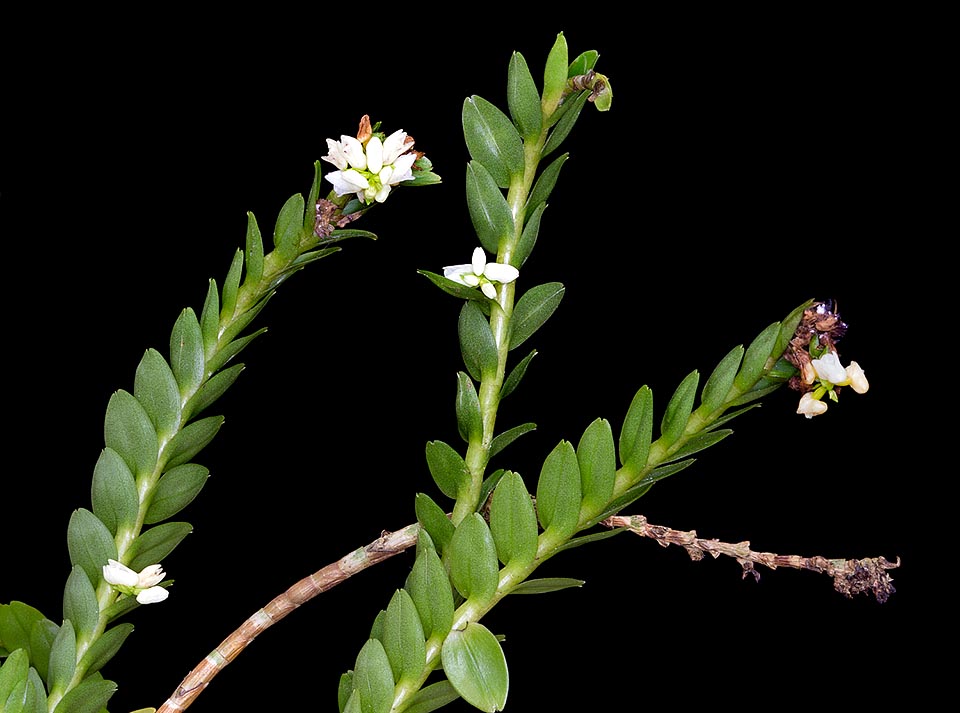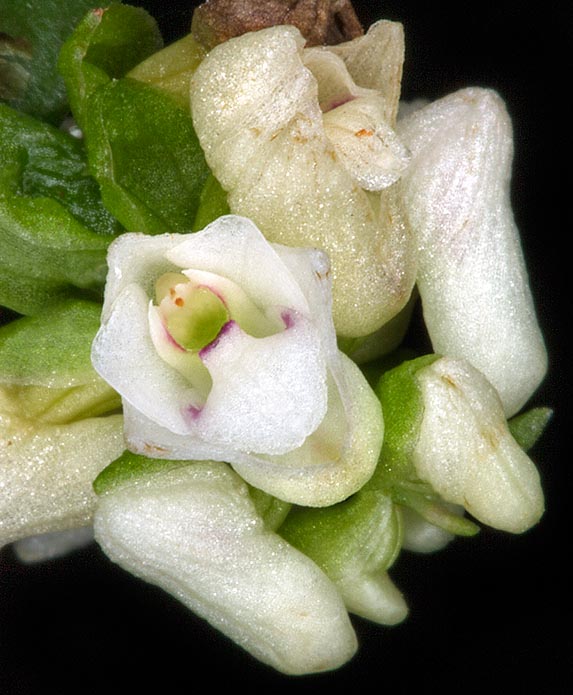Family : Orchidaceae

Text © Pietro Puccio

English translation by Mario Beltramini
The species is native to Assam, Borneo, Cambodia, China (Guangdong and Hainan), Java, Lesser Sunda Islands, Malaysia, Myanmar, North-Eastern India, Philippines, Sulawesi, Sumatra, Thailand and Vietnam where it grows on the trees of the tropical forests or on calcareous rocky slopes from the sea level up to about 1500 m of altitude.
The name of the genus is the Latin substantive “appendicula, ae” (diminutive of “appendix”) = small appendage, with reference to the callus on the labellum; the specific name is the Latin adjective “cornutus, a, um” = horned, provided of horns, with reference to the curved teeth placed on the two sides of the column.

Epiphyte or cespitose lythophyte, on branches and rocky calcareous slopes in the humid South-East Asian forests, Appendicula cornuta has even 60 cm long stems © Giuseppe Mazza
Common names: fern-leaf orchid, ladder orchid (English); niu chi lan (Chinese); hang maeng ngao (thai); lan chân rết móng, lan vệ mòng, (Vietnamese).
The Appendicula cornuta Blume (1825) is an epiphytic or lithophytic species, caespitose, with filiform villous roots, ascending or drooping not ramified stems, 25-60 cm long and of 2-3 mm of diameter, wholly covered by the foliar sheaths, and 0,5-1 cm internodes. Alternate leaves, distichous, ovate-oblong with irregularly bidentate or retuse apex, 2-3,5 cm long and 0,6-1,2 cm broad, coriaceous. Terminal inflorescences or lateral opposite to the leaves, 1-1,5 cm long, bearing 2-10 tiny close flowers, opening one-two at the time, of about 0,5 cm of diameter, of white colour, subtended by lanceolate floral bracts, concave, 0,5-0,8 cm long, of green colour.

1-1,5 cm inflorescences with 2-10 close tiny 0,5 cm flowers opening gradually. Curved teeth, like horns, on the sides of the column, as the name given by Blume to the species suggests © G. Mazza
Elliptic dorsal sepal with acute apex, concave, 3-4 mm long and about 2 mm broad, lateral sepals almost triangular with acute apex, 4-5 mm long and 2-2,5 mm broad, united at the base of the column to form a sort of spur (mentum) 1-3 mm long, oblong-obovate petals with obtuse apex, 2,5-3 mm long and 1-2 mm broad, and oblong-ovate labellum, 3,5-5 mm long and 1-2,5 mm broad, narrowed in the median part, at times with purple margins, fleshy.
The fruits are ovoid 5-6 mm long capsules of 1,5-2,5 mm of diameter.
It reproduces by seed, in vitro, and by division, with each section provided of at least 3-4 stems.
The most diffused in the wild of its genus, requires high luminosity, but without direct sun, intermediate temperatures, 20-30 °C, with lowest night temperatures not under the 16 °C, high atmospheric humidity, 75-85%, and constant ventilation. It can be mounted on trunks or bark, with a layer of sphagnum at the base, or cultivated in pots or baskets, also suspended, with a compost that can be formed by medium sliced bark fragments with addition of charcaol and inerts to improve the drainage and the circulation of the air around the roots.
Frequent waterings and nebulizations in order to maintain humid the roots, but avoiding the stagnations, utilizing rain water, demineralized or by reverse osmosis at ambient temperature. Fortnightly fertilizations during the vegetative season with a product specific for orchids at 1/3 the dosage shown on the package. The juice extracted from the stems is utilized in Indonesia in the treatment of the whitlows (inflammation of infectious origin interesting the fingers of the hands and of the feet).
The species is reported in the appendix II of CITES (species whose trade is internationally ruled).
Synonyms: Dendrobium manilense Schauer (1843); Appendicula bifaria Lindl. (1855); Appendicula manilensis (Schauer) Rchb.f. (1859); Appendicula reduplicata E.C.Parish & Rchb.f. (1878); Appendicula bifaria var. wallichiana Hook.f. (1890); Podochilus brachiatus Schltr. (1900); Podochilus cornutus (Blume) Schltr. (1900); Podochilus cyclopetalus Schltr. (1911); Appendicula brachiata (Schltr.) Schltr. (1912); Appendicula cyclopetala (Schltr.) Schltr. (1912); Dendrobium pseudorevolutum Guillaumin (1958).
→ For general notions about ORCHIDACEAE please click here.
